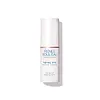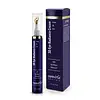What's inside
What's inside
 Key Ingredients
Key Ingredients

 Benefits
Benefits

 Concerns
Concerns

 Ingredients Side-by-side
Ingredients Side-by-side

Water
Skin ConditioningCaprylic/Capric Triglyceride
MaskingC12-15 Alkyl Benzoate
AntimicrobialHelianthus Annuus Seed Oil
EmollientCetyl Esters
EmollientGlycerin
HumectantCyclopentasiloxane
EmollientGlyceryl Stearate
EmollientPEG-100 Stearate
Cetearyl Methicone
Skin ConditioningEthylhexyl Palmitate
EmollientDimethicone
EmollientButyrospermum Parkii Butter
Skin ConditioningMagnesium Aluminum Silicate
AbsorbentPanthenol
Skin ConditioningAstaxanthin
Skin ConditioningLinoleic Acid
CleansingTocopherol
AntioxidantCeramide Ng
Skin ConditioningRosmarinus Officinalis Leaf Extract
AntimicrobialSodium Hyaluronate
HumectantAcetyl Octapeptide-3
HumectantPalmitoyl Hexapeptide-12
Skin ConditioningEthylhexylglycerin
Skin ConditioningStearic Acid
CleansingPhospholipids
Skin ConditioningPhytosterols
Skin ConditioningTribehenin
EmollientPolysorbate 80
EmulsifyingPEG-10 Phytosterol
EmulsifyingAcrylamide/Sodium Acryloyldimethyltaurate Copolymer
Emulsion StabilisingHydroxyethylcellulose
Emulsion StabilisingTrihydroxystearin
Skin ConditioningAmorphophallus Konjac Root Powder
AbrasiveIsohexadecane
EmollientPhytic Acid
Sodium Hydroxide
BufferingPhenoxyethanol
PreservativeWater, Caprylic/Capric Triglyceride, C12-15 Alkyl Benzoate, Helianthus Annuus Seed Oil, Cetyl Esters, Glycerin, Cyclopentasiloxane, Glyceryl Stearate, PEG-100 Stearate, Cetearyl Methicone, Ethylhexyl Palmitate, Dimethicone, Butyrospermum Parkii Butter, Magnesium Aluminum Silicate, Panthenol, Astaxanthin, Linoleic Acid, Tocopherol, Ceramide Ng, Rosmarinus Officinalis Leaf Extract, Sodium Hyaluronate, Acetyl Octapeptide-3, Palmitoyl Hexapeptide-12, Ethylhexylglycerin, Stearic Acid, Phospholipids, Phytosterols, Tribehenin, Polysorbate 80, PEG-10 Phytosterol, Acrylamide/Sodium Acryloyldimethyltaurate Copolymer, Hydroxyethylcellulose, Trihydroxystearin, Amorphophallus Konjac Root Powder, Isohexadecane, Phytic Acid, Sodium Hydroxide, Phenoxyethanol
Water
Skin ConditioningGlycerin
HumectantCetyl Ethylhexanoate
EmollientCyclopentasiloxane
EmollientCetyl Esters
EmollientPEG-100 Stearate
Glyceryl Stearate
EmollientC12-15 Alkyl Benzoate
AntimicrobialOctyldodecanol
EmollientButylene Glycol
HumectantPolyacrylate-13
Alpha-Arbutin
AntioxidantPalmitoyl Tripeptide-1
Skin ConditioningPalmitoyl Tetrapeptide-7
Skin ConditioningCeramide Ng
Skin ConditioningSodium Hyaluronate
HumectantAlbizia Julibrissin Bark Extract
MaskingCynanchum Atratum Extract
Skin ConditioningCardiospermum Halicacabum Flower/Leaf/Vine Extract
Skin ConditioningDarutoside
Skin ConditioningLeuconostoc/Radish Root Ferment Filtrate
AntimicrobialRibes Nigrum Seed Oil
EmollientRosmarinus Officinalis Leaf Extract
AntimicrobialHelianthus Annuus Seed Oil Unsaponifiables
EmollientHelianthus Annuus Seed Oil
EmollientPhospholipids
Skin ConditioningTocopherol
AntioxidantTocopheryl Acetate
AntioxidantUbiquinone
AntioxidantAlanyl Glutamine
HumectantCaprylic/Capric Triglyceride
MaskingBisabolol
MaskingTribehenin
EmollientPEG-10 Phytosterol
EmulsifyingDimethicone Crosspolymer
Emulsion StabilisingDimethicone
EmollientLaureth-23
CleansingLaureth-4
EmulsifyingPolyisobutene
Polysorbate 20
EmulsifyingCarbomer
Emulsion StabilisingSodium Benzoate
MaskingPotassium Sorbate
PreservativeLactic Acid
BufferingDisodium EDTA
Behenyl Alcohol
EmollientSerum Albumin
HumectantSodium Chloride
MaskingWater, Glycerin, Cetyl Ethylhexanoate, Cyclopentasiloxane, Cetyl Esters, PEG-100 Stearate, Glyceryl Stearate, C12-15 Alkyl Benzoate, Octyldodecanol, Butylene Glycol, Polyacrylate-13, Alpha-Arbutin, Palmitoyl Tripeptide-1, Palmitoyl Tetrapeptide-7, Ceramide Ng, Sodium Hyaluronate, Albizia Julibrissin Bark Extract, Cynanchum Atratum Extract, Cardiospermum Halicacabum Flower/Leaf/Vine Extract, Darutoside, Leuconostoc/Radish Root Ferment Filtrate, Ribes Nigrum Seed Oil, Rosmarinus Officinalis Leaf Extract, Helianthus Annuus Seed Oil Unsaponifiables, Helianthus Annuus Seed Oil, Phospholipids, Tocopherol, Tocopheryl Acetate, Ubiquinone, Alanyl Glutamine, Caprylic/Capric Triglyceride, Bisabolol, Tribehenin, PEG-10 Phytosterol, Dimethicone Crosspolymer, Dimethicone, Laureth-23, Laureth-4, Polyisobutene, Polysorbate 20, Carbomer, Sodium Benzoate, Potassium Sorbate, Lactic Acid, Disodium EDTA, Behenyl Alcohol, Serum Albumin, Sodium Chloride
 Reviews
Reviews

Ingredients Explained
These ingredients are found in both products.
Ingredients higher up in an ingredient list are typically present in a larger amount.
C12-15 Alkyl Benzoate is made up of Benzoic Acid and long chain alcohols. It has a low molecular weight.
C12-15 Alkyl Benzoate is an emollient and texture enhancer. Due to its solubility, it is often used in sunscreens to help evenly distribute active ingredients.
As an emollient, C12-15 Alkyl Benzoate helps soften and hydrate your skin. Emollients create a film on your skin that traps moisture within.
This ingredient has been reported to cause eye irritation.
Learn more about C12-15 Alkyl BenzoateThis ingredient is an emollient, solvent, and texture enhancer. It is considered a skin-softener by helping the skin prevent moisture loss.
It helps thicken a product's formula and makes it easier to spread by dissolving clumping compounds.
Caprylic Triglyceride is made by combining glycerin with coconut oil, forming a clear liquid.
While there is an assumption Caprylic Triglyceride can clog pores due to it being derived from coconut oil, there is no research supporting this.
Learn more about Caprylic/Capric TriglycerideCeramide NG is a type of Ceramide. The NG stands for a sphinganine base.
Ceramides are intercellular lipids naturally found in our skin that bonds dead skin cells together to create a barrier. They are known for their ability to hold water and thus are a great ingredient for dry skin.
Ceramides are an important building block for our skin barrier. A stronger barrier helps the skin look more firm and hydrated. By bolstering the skin ceramides act as a barrier against irritating ingredients. This can help with inflammation as well.
If you would like to eat ceramides, sweet potatoes contain a small amount.
Read more about other common types of ceramides here:
Ceramide AP
Ceramide EOP
Ceramide NP
Cetyl Esters is a synthetic wax made up of mostly fatty acids and fatty alcohols. It is strcturally similar to wax taken from whales.
As an emollient, it creates a thin barrier on the skin. This barrier prevents moisture from escaping.
This ingredient may not be fungal-acne safe.
Learn more about Cetyl EstersCyclopentasiloxane, or D5, is a silicone used to improve texture of products and trap moisture.
D5 is considered lightweight and volatile. Volatile means it evaporates quickly after application. Once evaporated, D5 leaves a thin barrier that helps keep skin hydrated.
It is also an emollient. Emollients help soften the skin and prevent water loss. Silicones create a silky texture in products. D5 helps other ingredients become more spreadable.
Studies show D5 is safe to use in skincare products. We recommend speaking with a skincare professional if you have concerns.
Learn more about CyclopentasiloxaneDimethicone is a type of synthetic silicone created from natural materials such as quartz.
What it does:
Dimethicone comes in different viscosities:
Depending on the viscosity, dimethicone has different properties.
Ingredients lists don't always show which type is used, so we recommend reaching out to the brand if you have questions about the viscosity.
This ingredient is unlikely to cause irritation because it does not get absorbed into skin. However, people with silicone allergies should be careful about using this ingredient.
Note: Dimethicone may contribute to pilling. This is because it is not oil or water soluble, so pilling may occur when layered with products. When mixed with heavy oils in a formula, the outcome is also quite greasy.
Learn more about DimethiconeGlycerin is already naturally found in your skin. It helps moisturize and protect your skin.
A study from 2016 found glycerin to be more effective as a humectant than AHAs and hyaluronic acid.
As a humectant, it helps the skin stay hydrated by pulling moisture to your skin. The low molecular weight of glycerin allows it to pull moisture into the deeper layers of your skin.
Hydrated skin improves your skin barrier; Your skin barrier helps protect against irritants and bacteria.
Glycerin has also been found to have antimicrobial and antiviral properties. Due to these properties, glycerin is often used in wound and burn treatments.
In cosmetics, glycerin is usually derived from plants such as soybean or palm. However, it can also be sourced from animals, such as tallow or animal fat.
This ingredient is organic, colorless, odorless, and non-toxic.
Glycerin is the name for this ingredient in American English. British English uses Glycerol/Glycerine.
Learn more about GlycerinGlyceryl Stearate is a mix of glycerin and stearic acid.
It is used to stabilize the mixing of water and oil ingredients. By preventing these ingredients from separating, it can help elongate shelf life. It can also help thicken the product's texture.
As an emollient, it helps soften skin and supports barrier-replenishing ingredients.
In cosmetics, Glyceryl Stearate is often made from vegetable oils or synthetically produced.
This ingredient may not be fungal-acne safe
Fun fact: The human body also creates Glyceryl Stearate naturally.
Learn more about Glyceryl StearateHelianthus Annuus Seed Oil is the oil derived from the seeds of a Sunflower. Sunflower seed oil is non-fragrant. It is an emollient, meaning it helps to soften the skin.
Sunflower seed oil contains many fatty acids. The fatty acids found in sunflower seeds include (from highest amount to least): linoleic acid, myristic acid, palmitic acid, stearic acid, arachidic acid, oleic acid, and linolenic acid.
These fatty acids help the skin create ceramides. Ceramides play a role in repairing the skin barrier.
Helianthus Annuus Seed Oil helps moisturize the skin. This in turn helps the skin look more rejuvenated and smoother.
Sunflowers are rich in vitamin E.
Historians believe Indigenous cultures of North America domesticated sunflowers before corn. Thus they relied on sunflower oil for a variety of uses. One such use is moisturizing skin and hair.
Sunflower seed oil may not be fungal acne safe. We recommend speaking with a professional if you have any concerns.
Learn more about Helianthus Annuus Seed OilWe don't have a description for PEG-10 Phytosterol yet.
Peg-100 Stearate is an emollient and emulsifier. As an emollient, it helps keep skin soft by trapping moisture in. On the other hand, emulsifiers help prevent oil and water from separating in a product.
PEGS are a hydrophilic polyether compound . There are 100 ethylene oxide monomers in Peg-100 Stearate. Peg-100 Stearate is polyethylene glycol ester of stearic acid.
Phospholipids are naturally found in our skin as they are the main component of cell membranes. Phospholipids have humectant, emollient, antioxidant properties.
Phospholipids are complex lipids that contain glycerin, two fatty acids, and a phosphate group. Some foods that contain phospholipids include soybeans and milk. The phospholipids found in soy come from Lecithin. This ingredient can also be synthetically created.
Due to their hygroscopic nature, they act as both humectants and emollients. Humectants draw moisture from the air to your skin, while emollients help trap moisture in.
The phospholipids in our skin can be naturally depleted. Replenishing the phospholipids in our skin can help hydrate your skin.
Studies show phospholipids display antioxidant activity and may help with reducing the signs of aging.
This ingredient is non-occlusive.
Some types of phospholipids:
Learn more about PhospholipidsRosmarinus Officinalis Leaf Extract comes from rosemary. Rosemary is native to the Mediterranean.
While Rosmarinus Officinalis Leaf Oil can be volatile due to its fragrant properties, the fragrance components are usually removed in the leaf extract.
Rosemary Leaf Extract contains many antioxidants such as rosmarinic acid and caffeic acid. Rosemarinic acid, a compound found in rosemary leaf, has been found to help soothe skin conditions such as eczema and acne.
Learn more about Rosmarinus Officinalis Leaf ExtractSodium Hyaluronate is hyaluronic acid's salt form. It is commonly derived from the sodium salt of hyaluronic acid.
Like hyaluronic acid, it is great at holding water and acts as a humectant. This makes it a great skin hydrating ingredient.
Sodium Hyaluronate is naturally occurring in our bodies and is mostly found in eye fluid and joints.
These are some other common types of Hyaluronic Acid:
Learn more about Sodium HyaluronateTocopherol (also known as Vitamin E) is a common antioxidant used to help protect the skin from free-radicals and strengthen the skin barrier. It's also fat soluble - this means our skin is great at absorbing it.
Vitamin E also helps keep your natural skin lipids healthy. Your lipid skin barrier naturally consists of lipids, ceramides, and fatty acids. Vitamin E offers extra protection for your skin’s lipid barrier, keeping your skin healthy and nourished.
Another benefit is a bit of UV protection. Vitamin E helps reduce the damage caused by UVB rays. (It should not replace your sunscreen). Combining it with Vitamin C can decrease sunburned cells and hyperpigmentation after UV exposure.
You might have noticed Vitamin E + C often paired together. This is because it is great at stabilizing Vitamin C. Using the two together helps increase the effectiveness of both ingredients.
There are often claims that Vitamin E can reduce/prevent scarring, but these claims haven't been confirmed by scientific research.
Learn more about TocopherolTribehenin comes from glycerin and behenic acid.
It is used as an emollient, or moisturizer. Emollients form a thin barrier on skin to prevent moisture from escaping.
This ingredient may not be Malassezia folliculitis, or fungal-acne safe.
Learn more about TribeheninWater. It's the most common cosmetic ingredient of all. You'll usually see it at the top of ingredient lists, meaning that it makes up the largest part of the product.
So why is it so popular? Water most often acts as a solvent - this means that it helps dissolve other ingredients into the formulation.
You'll also recognize water as that liquid we all need to stay alive. If you see this, drink a glass of water. Stay hydrated!
Learn more about Water